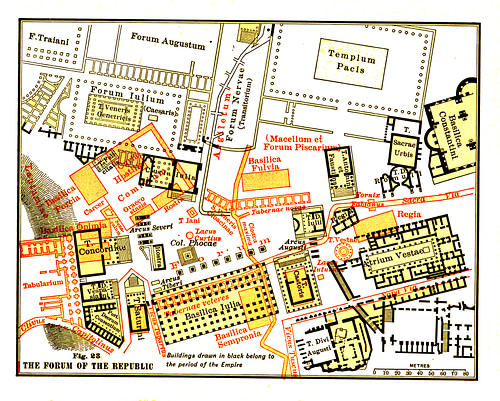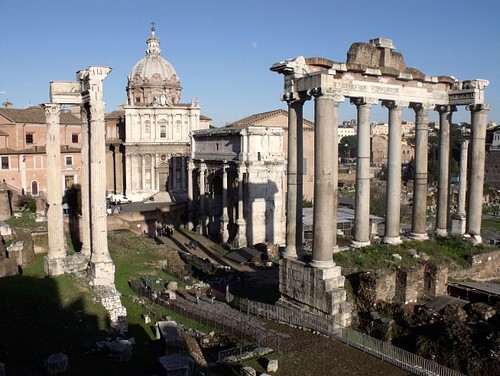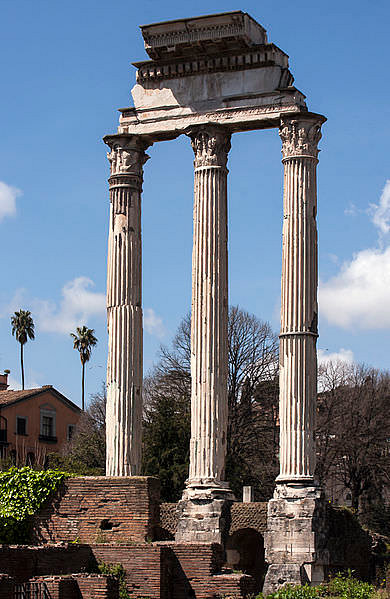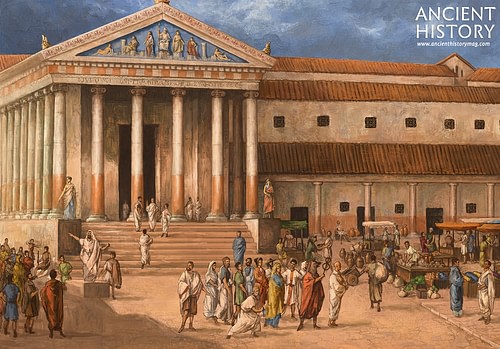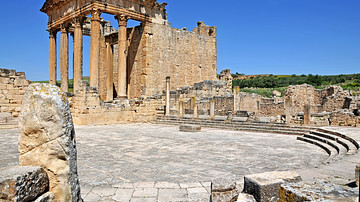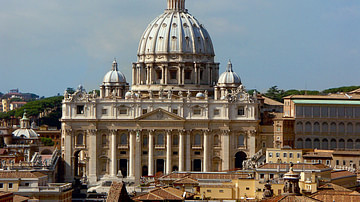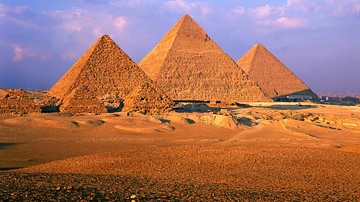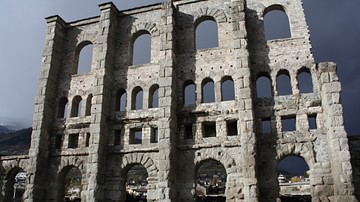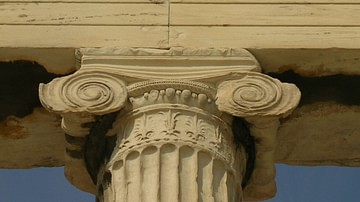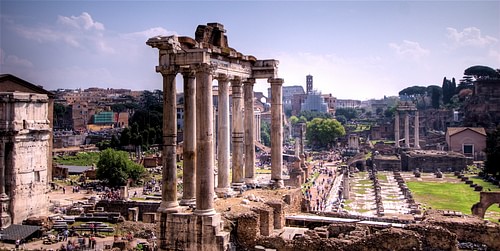
The Roman Forum or Forum Romanum of ancient Rome was the bustling religious, administrative, legal, and commercial heart of the city from the 7th century BCE onwards. Made increasingly grandiose and ceremonial in function by the Imperial Period, the Forum became a monumental symbol in stone and marble of Roman power and vanity with temples of deified emperors, dedicatory columns, and massive triumphal arches celebrating military victories from far corners of the Empire. Although wrecked by earthquake, weathering, pollution, and centuries of architects robbing it of its stones and columns, the Forum Romanum, nevertheless, remains one of the most impressive sites surviving from antiquity and a unique window into the once-great glorious world that was Rome.
HISTORICAL OVERVIEW
The Forum Romanum is located between the Capitoline and Palatine Hills of Rome. According to Roman legend, it was the site of a battle between Romans and Sabines in the second half of the 8th century BCE. Excavations at the Forum Romanum have revealed the presence of Iron Age cemeteries which were in use from the 11th century BCE until the 9th century BCE. The area was filled in with a significant quantity of earth and rubble fill in order to raise it above the level of the River Tiber's annual flood. The location was then paved, from the late 8th or early 7th century BCE. With early ritual spaces and temples such as the Regia and Temple of Vesta, the Forum became the public focal point of the city, the location of its most important religious, political, commercial, and legal activities. Gradually over the centuries, shops were pushed to the extremities or elsewhere, and the architecture became more imposing and ceremonial in function.
The first basilicas, used for public gatherings and especially law courts, appeared in the Forum from 184 BCE. Also in the 2nd century BCE, collonaded shops were added on three sides of the Forum. The principal thoroughfare was the via Sacra, a paved road which led from the Forum to the Palatine Hill. In 121 BCE the first triumphal arch was added, that of Fabius Maximus, proconsul in Transalpine Gaul. The 1st century BCE saw a great deal of construction activity, and the form of the Forum we see today largely dates from that era. Lucius Cornelius Sulla (138-78 BCE) built a larger Curia building, home of the extended Roman Senate, and paved the Forum with white travertine.
Various new buildings appeared during the reigns of Julius Caesar (100-44 BCE) and Augustus (r. 27 BCE - 14 CE). The latter, in particular, made extensive renovations to many existing structures and commemorated the place of Caesar's funeral pyre with a column, replaced in 29 BCE with the temple of Divus Iulius following Caesar's deification. Augustus' reign also saw the Forum repaved using marble and the cleaning out of the sewers beneath it. In 10 CE the Temple of Concordia Augusta, which was sometimes used for Senate meetings, was rebuilt, and the sum of this work was to create a shining new monumental Forum enclosed in marble colonnades which, with regular additions of temples, columns, statues and arches, advertised the power, wealth, and military successes of the Roman emperors.
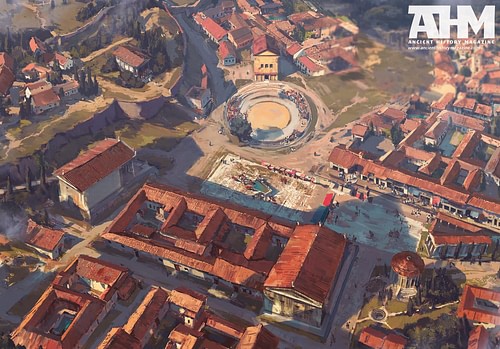
Throughout the Imperial Period various temples were set up to commemorate deified emperors, including Augustus, Vespasian (r. 69-79 CE), and Antoninus Pius (r. 138-161 CE) and his wife, the empress Annia Galeria Faustina. Domitian (r. 81-96 CE) added a statue of himself riding a horse in 91 CE. Triumphal arches to commemorate military victories were added, notably the Arch of Titus in c. 81 CE and that of Septimius Severus in 203 CE.
The Forum was devastated by fire in 283 CE which necessitated much rebuilding and restoration work, including a new Curia and a new monumental colonnade. The Forum eventually fell into decline, even if it was occasionally used for ceremonial purposes, following the move of the capital of the Roman Empire to Constantinople in 330 CE. In the mid-6th century CE, the church of Santa Maria Antiqua was built in the Forum on the slopes of the Palatine Hill but was then buried in a landslide in 847 CE. One of the last additions, when the Forum had become no more than a marketplace, was the 13-metre high column of Phocas, the emperor of Byzantium and former centurion, in 608 CE.
Many of the buildings were cannibalised for their stonework or burned for lime, especially in the 15th and 16th century CE. This seriously weakened those left standing and made them susceptible to collapse from earthquakes. The Arch of Titus was incorporated into fortifications built by the Frangipani family in medieval times and suffered as a consequence. The Arch of Septimius Severus was similarly made into a fortress with towers added to it and once there were shops inside its archways. Weathering and pollution have since significantly damaged many of the Forum's buildings and especially their decorative sculpture.
ARCHITECTURAL HIGHLIGHTS - RELIGIOUS BUILDINGS
Regia
First built sometime in the 7th century BCE and modified several times over the centuries, the original Regia was probably a trapezoidal building with a wing and attached courtyard. The name ('Royal Palace') suggests a use as a throne room for Rome's early kings but archaeological evidence of altars and sacrifices point to a religious function during the 6th century BCE. In imperial times it was used as offices and a place of meeting by some of Rome's most important religious officials such as the Vestal Virgins and Pontifex Maximus. Included in its precinct were two sacred bay trees and a shrine with the shields and spears of Mars, which generals were meant to rattle before they embarked on campaigns. The building was remodelled in 210 BCE, 148 BCE and 36 BCE but survived the fires of the 1st century CE. Today only the ground plan is discernible.
Comitium
The Comitium began in the late 7th century BCE as a simple triangular paved space for religious ceremonies but eventually acquired a stepped platform and ship's prows were affixed to the speaker's podium (rostra). From the 4th century BCE, the general shape of the Comitium took on the circular form familiar from Greek ekklesiasteria (public assembly forums). After being repaved at least seven times over time, the Comitium ceased to exist as a specific monument in the 1st century BCE when Julius Caesar eradicated it. There still remains today at the site a mysterious black stone, the Lapis Niger, which carries an inscription of what seems to be a set of regulations for a ritual. The late Republican Romans believed the stone marked the grave of Romulus, the legendary founder of the city.
Temple of Vesta
The circular Temple of Vesta, dedicated to the Roman goddess of the hearth, was first built in the 7th century BCE. By the late Republic the temple had been transformed into the form of a primitive house with columns around its perimeter, inside of which was a hearth and other sacred objects but no statue of the goddess. Legend has it the Palladium, a small wooden statue of Minerva, which was taken from Troy by Aeneas in Roman mythology, was kept here in an underground chamber. Today only the base and a short elevation of reconstructed travertine blocks survive.
House of the Vestal Virgins
The House of the Vestal Virgins or Atrium Vestae, located just behind the Temple of Vesta, was a project begun by Domitian and completed by Trajan c. 113 CE. The structure, with its distinctive three sides of two-tiered colonnades in green and red marble, was built upon the site of an earlier temple dating to the 2nd or 1st century BCE. The building was restored c. 150 CE and the enclosed gardens once had many statues, including figures of Head Vestals such as Flavia Publicia (247-257 CE).
Temple of Saturn
This temple was dedicated to Saturn, a somewhat mysterious god in the Roman pantheon who was perhaps a version of the Greek Kronos (Cronus). Saturn was especially worshipped in the Saturnalia festival held every 17th of December (from at least the 5th century BCE), a festive occasion when people gave gifts to one another, slaves had the freedoms enjoyed by ordinary citizens, and there was a general round of partying and merrymaking.
The surviving version of the Temple of Saturn dates to sometime between 360 and 380 CE. The temple was built on the site of the original building dedicated c. 497 BCE by the dictator Titus Tatius, which itself had replaced the god's first shrine, the Ara Saturni. During the Republic, the temple also housed the public treasury (aerarium), a function it kept, albeit in a more limited capacity, in the Imperial Period.
The temple stands on a pediment of travertine blocks while the eight remaining columns are of the Ionic order. The shafts of the columns are made from Egyptian granite, the two on the side from pink Aswan, and the six facade ones from grey Mons Claudianus. The Ionic capitals are, in fact, the only parts made specifically for the temple. Within the temple once stood a cult statue of Saturn.
Temple of Castor & Pollux
The Temple of Castor and Pollux (aka Dioscuri) was erected in the final decade of the 1st century BCE, replacing the earlier temple to the twin sons of Jupiter which had stood on the site since 484 BCE. Every 15th of July the temple was the focus of a cavalry parade - the transvectio - of 5,000 men led by two impersonators of the demigods who were thought to have guided the Romans to victory over the Latins at the Battle of Lake Regillus (499 or 496 BCE). The twins were seen afterwards watering their horses at the Juturna spring which was the very spot where their temple was built.
Today only the large podium survives of the original temple and the inner concrete core of the podium and three columns of the 1st century BCE version, built by Augustus in 14 or 9 BCE after a devastating fire. Augustus also made the cult an official imperial one and initiated a new feast day for the pair on the 27th of January. The once massive structure measured 32 x 50 m and reached a height of almost 19 m. The facades had eight Corinthian columns whilst the sides each had eleven. The original front entrance was composed of twin staircases with a speaker's platform, changed in the 3rd century CE to a single staircase. The interior of the temple was quite complex and consisted of some 25 small chambers. The temple served as the office of weights and measures with an additional function as a bank.
Temple of Divus Antoninus Pius & Faustina
The temple dedicated to Emperor Antoninus Pius and Empress Faustina was built c. 140 CE. Six Corinthian columns of the facade still stand, along with two at each side, behind which lurks the 17th-century CE version of the church of Saint Lorenzo (first installed in the 6th or 7th century CE) in an incongruous mix of religions and architectural styles. First dedicated by Antoninus to his deified wife, 20 years later it would also be dedicated to the deified emperor. Inside were once colossal statues of the divine pair, fragments of which have been excavated from the temple grounds.
Portico Dei Consentes
The Portico Dei Consenetes was a trapezoidal platform built on seven vaulted chambers and topped with a portico of 12 Corinthian columns in green marble. Dating to the reign of Hadrian (r. 117-138 CE), the structure was decorated with statues of the Harmonious Gods (a Roman version of the 12 Greek Olympian gods). The structure was repaired in 367 CE by the city prefect, one Vettius Agorius Praetextatus, who was a rare pagan in the new Christian world of Rome.
TRIUMPHAL ARCHES
Arch of Titus
The Arch of Titus was erected by Domitian in c. 81 CE to commemorate the victories of his father Vespasian and brother Titus in the Jewish War in Judaea (70-71 CE) when the great city of Jerusalem was sacked and the vast riches of its temple plundered. The arch is also a political and religious statement expressing the divinity of the late emperor Titus.
Constructed using Pentelic and Luna marble, the arch's decorative relief panels show the triumph procession carrying booty from the Temple of Jerusalem and Titus riding a four-horse chariot (quadriga) and being crowned by a personification of Victory. The goddess Roma stands in front, holding the bridle of one of the horses. Originally, a huge bronze quadriga would have stood on top of the arch.
Arch of Septimius Severus
The Arch of Septimius Severus, erected in 203 CE, commemorates the Roman victories over the Parthians in the final decade of the 2nd century CE. The larger central archway was used for traffic, whilst the two outer arches were closed off by steps. The foundations are of travertine and the main structure of Proconnesian marble, a feature of which is its grey and white bands. The arch was richly decorated with sculpture which depicted scenes from the military campaigns in Parthia, the triumph procession, the seasons, various deities, and victories. On top of the structure, as indicated in coins of the period, there would once have been a six-horse chariot in gilded bronze on which rode a statue of Septimius Severus. The emperor was also originally flanked by his two sons on horseback, possibly rendered in silver.
SECULAR BUILDINGS
Curia
The Curia was the most commonly used building for meetings of the Roman Senate. The first building was the Curia Hostilia, used in the Early Kingdom, then the Curia Cornelia, built by Sulla, and finally, the Curia Julia, built by Caesar, finished by Augustus and used thereafter. The sessions were open to the public with a literal open-door policy that allowed ordinary people to sit outside and listen in if they wished. The Curia was restored by Domitian in 94 CE, and rebuilt, as mentioned, following the fire of 283 CE. The rectangular building measures 25.6 x 17.8 m, has a height of 31.6 m, and was built using brick with a concrete facing. The flooring has survived well and is an excellent example of opus sectile marble mosaic; the doors, in contrast, are bronze replicas of the originals. The Curia was converted into the church of Saint Hadrian in 630 CE.
Basilica of Maxentius & Constantine
The New Basilica was begun by Maxentius and finished by Constantine c. 313 CE. It once measured around 96 x 65 metres. The interior was covered in marble panels, had a coloured marble flooring and soaring vaults. The building was the home of the Urban Prefects, the most important officials in the city, and the seat of the Senatorial court, the Secretarium Senatus. The western apse once contained a colossal statue of Constantine, the head, foot and other surviving remains of which are now on display in the courtyard of the Palazzo dei Conservatori. Although the building was largely destroyed by the earthquake of 847 CE, several 25-metre high vaults are still intact and loom over the other ruins of the Forum.
